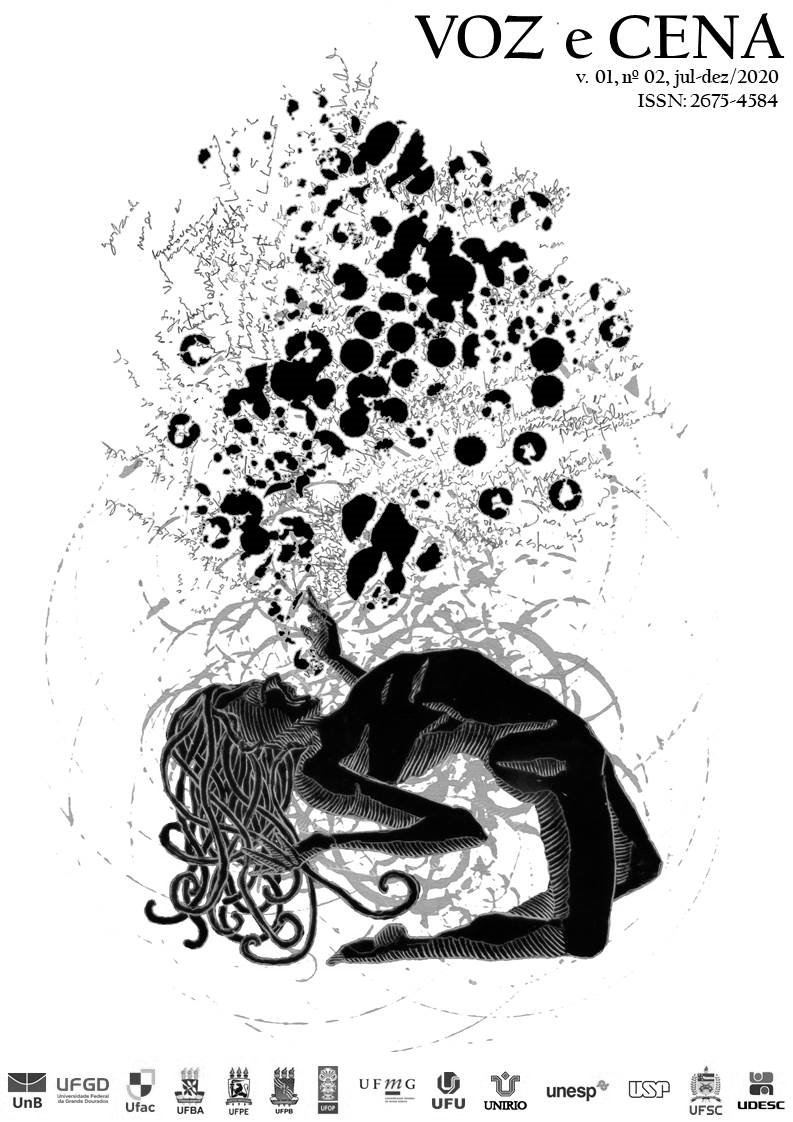Paths of the Voice
DOI:
https://doi.org/10.26512/vozcen.v1i02.33340Keywords:
Vocal Body, Creation Process, Feminine, Memory, Corporeal MimesisAbstract
This article proposes to narrate a path of formation, research and performance in the field of voice for theater. The actress/researcher describes the beginning of her artistic career and how the voice has always been present as a primary element of her history. She highlights the importance of vocal technique and the study of musicality for the creation of a the actor’s score, with the body and the voice. About musicality, there is the dialogue with the thesis of Jacyan Oliveira (2008) and the dissertation of Eleonora Montenegro (2001). The term vocal body is used in the article according to the thesis of Daiane Jacobs (2015). The actress/researcher also talks about the relation between vocal body, identity, emotions, gender issues and accent, based on the works of Janaína Martins (2008) and Alexander Lowen (1982) and on her experience as a professor of the Theater Graduation at the Federal University of Rio Grande do Norte. She briefly discusses the process of creating her solo “Violetas”, from the methodology of Corporeal Mimesis (Hirson, 2012 and Colla, 2006) and the importance of this process for her research in the field of voice. Finally, she presents her hypothesis for her doctoral research at the State University of Santa Catarina, which begins in the second half of this year.
Downloads
References
BARBA, Eugênio. Além das Ilhas Flutuantes. Campinas, São Paulo: Hucitec/Unicamp, 1991.
BUTLER, Judith. Problemas de Gênero: feminismo e subversão da identidade. Rio de Janeiro: Civilização Brasileira, 2016.
CALDWELL, Timothy & ABRAMSON, Robert M. Dalcroze Eurhythmics. Central Michigan University, USA, 1992. G.I.A. Publication, Inc. [Vídeo-aula].
COLLA, Ana Cristina. Da minha janela vejo: relato de uma trajetória pessoal de pesquisa no Lume. São Paulo: Hucitec, 2006.
DOURADO, Rodrigo Carvalho Marques. Bonecas falando para o mundo: identidades “desviantes” de gênero e sexualidade no teatro. Recife: Sesc, 2017.
HIRSON, Raquel Scotti. Alphonsus de Guimaraens: Reconstruções da Memória e Recriações no Corpo. Campinas: PPG Artes da Cena/UNICAMP, 2012. Tese (Doutorado em Artes da Cena).
JACOBS, Daiane Dordete Steckert. Possível Cartografia para um Corpo Vocal Queer em Performance. PPGT/UDESC, 2015. Tese (Doutorado em Teatro).
LECOQ, Jacques. O Corpo Poético. Uma pedagogia da criação teatral. São Paulo: Senac e Sesc, 2010.
LOWEN, Alexander. Bioenergética. São Paulo: Summus, 1982.
MARTINS, Janaína Träsel. Os princípios da ressonância vocal na ludicidade dos jogos de corpo-voz para a formação do ator. Salvador: PPGAC/UFBA, 2008. Tese (Doutorado em Artes Cênicas).
OLIVEIRA, Jacyan Castilho de. O Ritmo Musical da Cena Teatral. A dinâmica do espetáculo de teatro. Salvador: PPGAC/UFBA, 2008. Tese (Doutorado em Artes Cênicas).
PHILIPPE, Pedro. Violetas Arraes: como falar de uma flor? Revista Cariri, Juazeiro do Norte, 12 de Julho de 2017. Disponível em https://caririrevista.com.br/como-falar-de-uma-flor/. Acesso em 10 de agosto de 2020.
SCHAFER, Murray. O Ouvido Pensante. São Paulo: UNESP, 1991.
SIMIONI, Carlos, PECLÁT, Chavannes. Entrevista sobre voz e treinamento vocal com Carlos Simioni. Urdimento, Florianópolis, v.1, n.34, pp. 405-420, mar./abr. 2019.
SOUZA, Maria Eleonora Montenegro de. A Alma das Palavras - a voz enquanto imagem das palavras: uma proposta de leitura e em cena-ação. Salvador: PPGAC/UFBA, 2001. Dissertação (Mestrado em Artes Cênicas).
SOUZA, Mayra Montenegro de. A Voz em Violetas. ILINX - Revista do Lume, Campinas, v.1, n.12, pp. 40-49, 2017.
SOUZA, Mayra Montenegro de. O Ator que Conta um Conto: a manipulação de parâmetros musicais na voz do ator. Natal: PPGARC/UFRN, 2012. Dissertação (Mestrado em Artes Cênicas).
VIEIRA, Laise Aparecida Diogo. A Língua Falada no Teatro e em Telenovelas Brasileiras: um percurso pela história das ideias linguísticas. Línguas e Instrumentos Linguísticos, Campinas, v. 23, n. 45, pp. 46-89, jan./jun. 2020.
ZUMTHOR, Paul. Introdução à Poesia Oral. Belo Horizonte: UFMG, 2010.
Downloads
Published
How to Cite
Issue
Section
Categories
License
Copyright (c) 2020 Voz e Cena (Voice and Scene)

This work is licensed under a Creative Commons Attribution 4.0 International License.
Readers are free to download, print and use the articles published in the journal, as long as there is always explicit mention to the authors and to the Voz e Cena journal and that there is no change in the original work. Any other use of the texts must be approved by the authors and the journal. By submitting a paper to Voz e Cena journal and having it approved, the authors agree to assign, without remuneration, the rights of first publication and the permission for the journal to redistribute that article and its metadata to the indexing and reference services that its publishers deem appropriate.
This work is licensed under a Creative Commons Attribution 4.0 International License.![]()


7.PNG)


